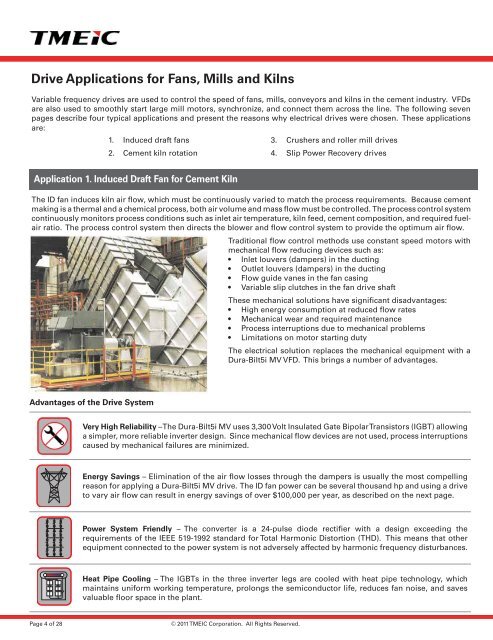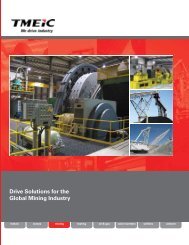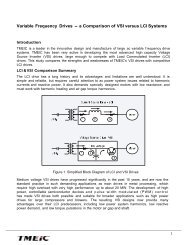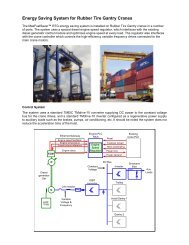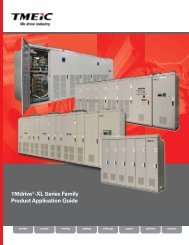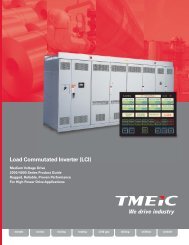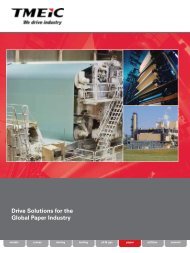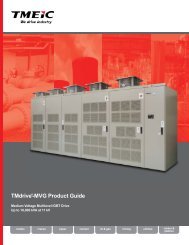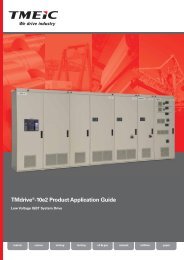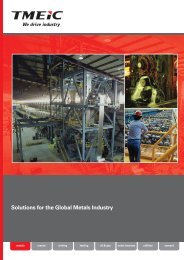Drive Solutions for the Global Cement Industry (email) - Tmeic.com
Drive Solutions for the Global Cement Industry (email) - Tmeic.com
Drive Solutions for the Global Cement Industry (email) - Tmeic.com
You also want an ePaper? Increase the reach of your titles
YUMPU automatically turns print PDFs into web optimized ePapers that Google loves.
<strong>Drive</strong> Applications <strong>for</strong> Fans, Mills and Kilns<br />
Variable frequency drives are used to control <strong>the</strong> speed of fans, mills, conveyors and kilns in <strong>the</strong> cement industry. VFDs<br />
are also used to smoothly start large mill motors, synchronize, and connect <strong>the</strong>m across <strong>the</strong> line. The following seven<br />
pages describe four typical applications and present <strong>the</strong> reasons why electrical drives were chosen. These applications<br />
are:<br />
1. Induced draft fans<br />
3. Crushers and roller mill drives<br />
2. <strong>Cement</strong> kiln rotation<br />
4. Slip Power Recovery drives<br />
Application 1. Induced Draft Fan <strong>for</strong> <strong>Cement</strong> Kiln<br />
The ID fan induces kiln air flow, which must be continuously varied to match <strong>the</strong> process requirements. Because cement<br />
making is a <strong>the</strong>rmal and a chemical process, both air volume and mass flow must be controlled. The process control system<br />
continuously monitors process conditions such as inlet air temperature, kiln feed, cement <strong>com</strong>position, and required fuelair<br />
ratio. The process control system <strong>the</strong>n directs <strong>the</strong> blower and flow control system to provide <strong>the</strong> optimum air flow.<br />
Traditional flow control methods use constant speed motors with<br />
mechanical flow reducing devices such as:<br />
• Inlet louvers (dampers) in <strong>the</strong> ducting<br />
• Outlet louvers (dampers) in <strong>the</strong> ducting<br />
• Flow guide vanes in <strong>the</strong> fan casing<br />
• Variable slip clutches in <strong>the</strong> fan drive shaft<br />
These mechanical solutions have significant disadvantages:<br />
• High energy consumption at reduced flow rates<br />
• Mechanical wear and required maintenance<br />
• Process interruptions due to mechanical problems<br />
• Limitations on motor starting duty<br />
The electrical solution replaces <strong>the</strong> mechanical equipment with a<br />
Dura-Bilt5i MV VFD. This brings a number of advantages.<br />
Advantages of <strong>the</strong> <strong>Drive</strong> System<br />
Very High Reliability – The Dura-Bilt5i MV uses 3,300 Volt Insulated Gate Bipolar Transistors (IGBT) allowing<br />
a simpler, more reliable inverter design. Since mechanical flow devices are not used, process interruptions<br />
caused by mechanical failures are minimized.<br />
Energy Savings – Elimination of <strong>the</strong> air flow losses through <strong>the</strong> dampers is usually <strong>the</strong> most <strong>com</strong>pelling<br />
reason <strong>for</strong> applying a Dura-Bilt5i MV drive. The ID fan power can be several thousand hp and using a drive<br />
to vary air flow can result in energy savings of over $100,000 per year, as described on <strong>the</strong> next page.<br />
Power System Friendly – The converter is a 24-pulse diode rectifier with a design exceeding <strong>the</strong><br />
requirements of <strong>the</strong> IEEE 519-1992 standard <strong>for</strong> Total Harmonic Distortion (THD). This means that o<strong>the</strong>r<br />
equipment connected to <strong>the</strong> power system is not adversely affected by harmonic frequency disturbances.<br />
Heat Pipe Cooling – The IGBTs in <strong>the</strong> three inverter legs are cooled with heat pipe technology, which<br />
maintains uni<strong>for</strong>m working temperature, prolongs <strong>the</strong> semiconductor life, reduces fan noise, and saves<br />
valuable floor space in <strong>the</strong> plant.<br />
Page 4 of 28<br />
© 2011 TMEIC Corporation. All Rights Reserved.


